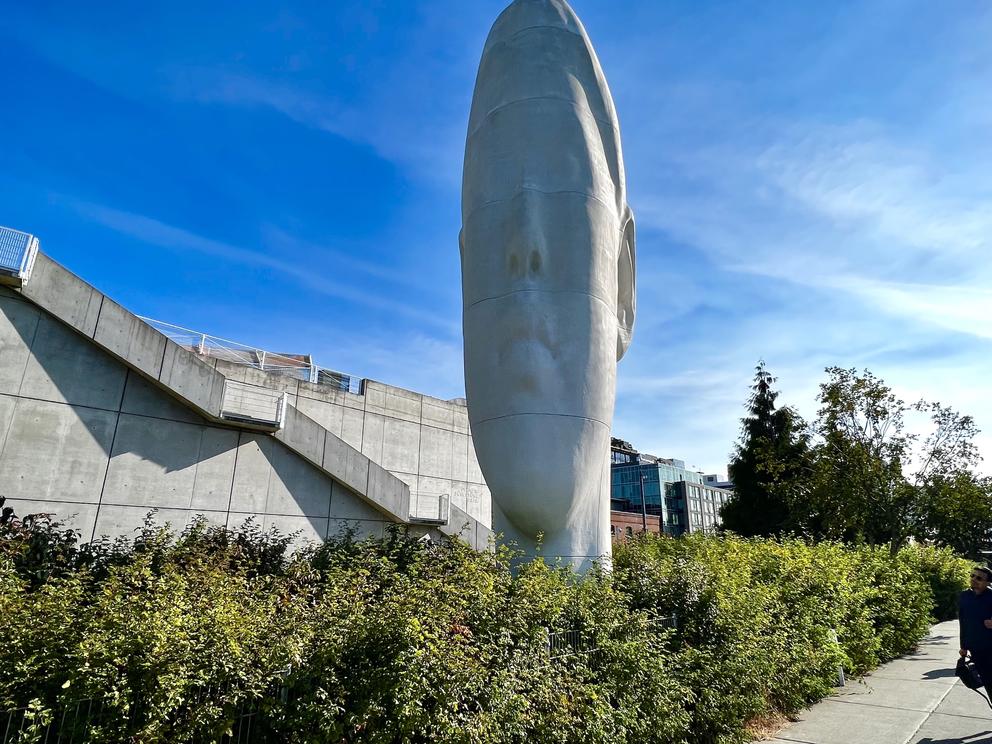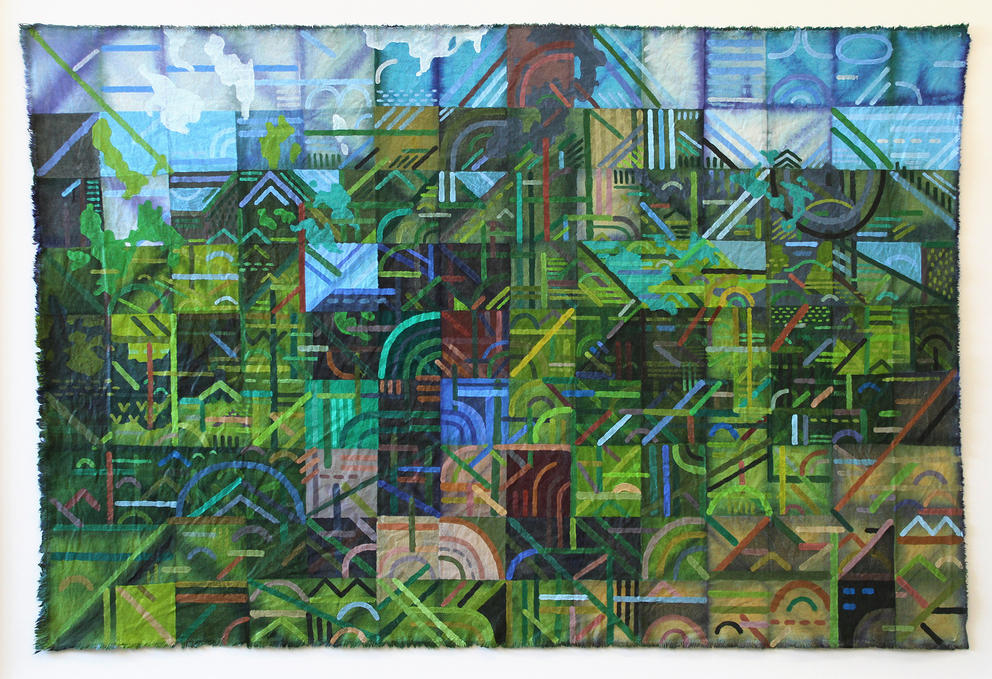It wasn’t the only Seattle cultural connection I encountered in Spain (and oddly, not the only taxi ride that featured Nirvana on the radio).
ArtSEA: Notes on Northwest Culture is Crosscut’s weekly arts & culture newsletter.
On the first morning, jetlagged and wandering around our AirBnb neighborhood, I immediately saw a familiar face: one that looked a lot like the huge, white “Echo” at the Olympic Sculpture Park. Sure enough, it was another larger-than-life bust by Barcelona-born contemporary artist Jaume Plensa. This sculpture is a younger sister of sorts, “Carmela,” made of cast iron instead of white polymer. But she has the same meditative aura and digitally skewed visage as her Seattle sibling.
Whether you’re seeking them out or trying to escape, these hints of home have a way of following you around — and making the world a bit smaller after all.
At a tiny espadrille shop, we happened to meet an ex-pat Evergreen grad. At a baroque 18th-century basilica, we stumbled upon a pipe-organ concert featuring John Cage’s music. At a 91-year old tapas bar, the Spanish waiter lit up when we said we were from Seattle. “My boyfriend is from Bellingham!” he said. “I love Seattle!” And on another cab ride (this time accompanied by Nirvana’s cover of David Bowie’s “The Man Who Sold the World”) the driver said, “Seattle? Los Supersonics!”
Just as traces of Seattle seemed to follow me around Spain, now that I’m back, I’m seeing Spain all over. On the way into the Crosscut office, I realized there’s another Plensa sculpture close by: “Mirall” (“Mirror”), in which two seated steel figures — their bodies made of letters from different alphabets — face each other on Mercer Street outside the Allen Institute for Brain Science.
Having sought out 20th-century Spanish masterworks in Spain, including those by Antoni Gaudí, Pablo Picasso, Joan Miró and Salvador Dalí, I was excited to see the lineup for the new show at Frederick Holmes Gallery in Pioneer Square. Makers of a New World: The American and European Avant Garde, 1915-1965 (through Dec. 31) offers a rich collection and art history lesson that includes delicate etchings by Picasso and Dalí and a playfully mysterious color lithograph by Miró.
The show also includes lithographs by Alexander Calder and Mark Tobey and several works by little-known American artist Walter Quirt (1902-1968), who gallerist Holmes told me he has been working to reintroduce. Quirt was once amid the American avant garde, with works that at times recall the cubism of Picasso, the minimalist lines of Miró and the stretched-out surrealism of Dalí. In 1944, The New Yorker’s art critic dubbed him “one of the most impassioned artists alive today.” But Quirt fell into obscurity for several reasons, including a move from New York City to Milwaukee — another lesson in location, location, location.
Travel always makes you look at where you live in a new light, and my trip also brought a fresh perspective to the Seattle art shows I explored last weekend. At Linda Hodges Gallery, longtime Seattle artist Cable Griffith is showing We followed the trail until we disappeared (through Oct. 29; artist talk Oct. 22 at noon), a collection of mostly recent paintings in his trademark abstract style.
His grids of colored squares peppered with symbols have often brought quilts or mosaic murals to my mind. But having recently visited Gaudí’s gobsmacking Sagrada Familia cathedral in Barcelona, I suddenly saw Griffith’s paintings as blueprints for stained glass windows. (When embarking on your own travels, you can see an actual colored glass installation of his in Concourse C at Sea-Tac airport, and stay tuned for another going in at the new Redmond light rail station.)
In Gaudí’s cathedral (commenced in 1882 and still in progress), the light filters through innumerable panes of stained glass, casting an intense glow throughout the nave. On the east side, the hues are all blues and greens; on the west, reds, oranges and yellows suggest the sunset. Griffith tends to keep his palettes either cool or warm, too, particularly in his loosely unstretched canvas paintings, which resemble woven tapestries. The work of both artists reflects a yearning for nature, for sunlight dappled through tall, dark trees.
Gaudí balked at straight lines, preferring to use organic shapes to direct his designs — an approach now known as “biomimetic architecture.” One of Sagrada Familia’s most striking features (of countless) are soaring columns that branch at the top and give the feeling of ancient forests. A look at Griffith’s titles reflects the same desire for immersion, for sparking a sense memory of traveling through nature: “The bridge was wet with mist and moss,” “The river, leaves and fire had a tempo all their own,” “And so got deeper and deeper into the woods.”
Seeing several spectacular stained-glass “rose windows” around Spain gave me a new view of Seattle’s thriving glass art scene. At Traver Gallery (through Nov. 5), Northwest artists John Kiley and a guy named Dale Chihuly are showing off their skills at capturing light in colored glass — Kiley with contained, geometric forms and Chihuly exhibiting melty undersea vessels. (And there’s plenty more to see in the Refract glass art festival this weekend.)
In addition to stunningly realistic wood carvings by Humaira Abid, Greg Kucera Gallery just opened a show of work by “Northwest School” artist Paul Horiuchi (1906-1999) titled Paintings and Collage (through Oct. 29). Perhaps best known locally for his sparkling mosaic glass mural at Seattle Center, Horiuchi studied calligraphy, Sumi ink painting and watercolor — Japanese techniques that also influenced Miró after he visited Japan in 1966. In this exhibit, Horiuchi’s bold shapes embrace abstract expressionism as they jitter, smash and float across the canvases.
At AMcE Creative Arts on Capitol Hill, artist Robert Hardgrave celebrates 30 years in Seattle with Pearl (through Oct. 30), an array of paintings and sculpture that combine graphic cubist shapes, vibrant color fields and surrealist visions of hybrid human forms. And in Bodies of Land at ArtXChange Gallery (through Nov. 19), Seattle ceramicist Hanako O’Leary and painter Ann Leda Shapiro recall Dalí’s surreal and sexual sensibility — with a powerful feminist twist — in works that turn human body parts into dreamscapes, including a mountain of origami vulvas.
I know this travel haze will burn off like jet lag, but for the moment I’m enjoying the lingering effects of Spain on my brain.
Get the latest in local arts and culture
This weekly newsletter brings arts news and cultural events straight to your inbox.






